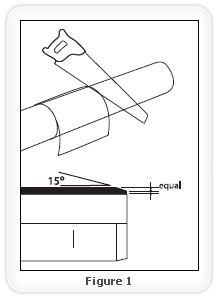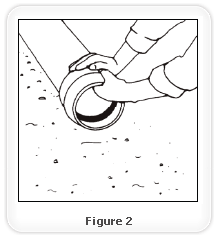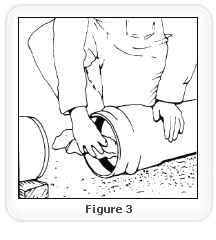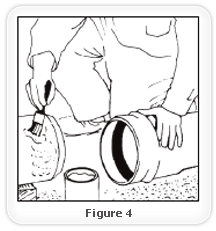Pipe Jointing Procedures
PREPARING PIPE ENDS
All spigots on fittings and the ends of standard lengths of pipe are chamfered to approximately 15° degree. Pipes cut on site must be clean cut at right angles to their horizontal axis. Chamfer the cue end to approximately 15° for half the pipe wall thickness and deburr it with a scraper or knife blade. (Figure 1).

All pipes – whether site cut or otherwise and other plain ended fittings must be inserted to the full depth of the socket, marked at the socket face, and then withdrawn at least 12mm.
JOINTING 110MM DIAMETER PIPES
It is necessary with pipes of 110mm diameter to provide lateral support to the socket whilst pushing the spigot end of the pipe home to its depth of entry mark. This is necessary because of the lower longitudinal stiffness of these small pipes and their tendencies to lateral deflection prior to final entry of the spigot into the rubber seal.
RING SEAL JOINTS
Pipe Couplers and must Bends and Junctions – particularly in the 110mm, 160mm and 200mm sizes – are available with sockets on all ends. These sockets are fitted with ring seals which act as both a sealing and expansion joint.
♦ The correct sequence for ring seal jointing is as follows :
1. Check that the pipe chamfer is correct and that the ring seal is properly seated in its housing. (Figure 2)

2. Make sure that both the pipe or fitting spigot and ring socket are dry, clean and free from grit or dust. (Figure 3)

3. Lubricate evenly around the spigot (Not the socket) with Lubricant. (Figure 4)

4. Make sure that the components to be joined are correctly aligned. (Figure 5)

♦ Jointing Pipe:
5. Push the spigot fully into the socket. Mark the spigot at the socket face and then withdraw the spigot by a minimum of 12mm. if the spigot is already marked with the depth of entry, push into the socket until the depth of entry mark is just visible. (Figure 6)

Make a subsequent check to ensure that the expansion gap is not lost during further installation work.
6. Do not cut back the straight leg sections of Long Radius Bends for Channel Bends as only the spigot end provided is suitable for jointing.
7. Make jointing 200, 250mm and 315mm pipes easier by levering them into position. Protect the pipe end (or socket mouth in the case of single socket pipes) from the leaving by placing a block of wood between the pipe and the lever.
